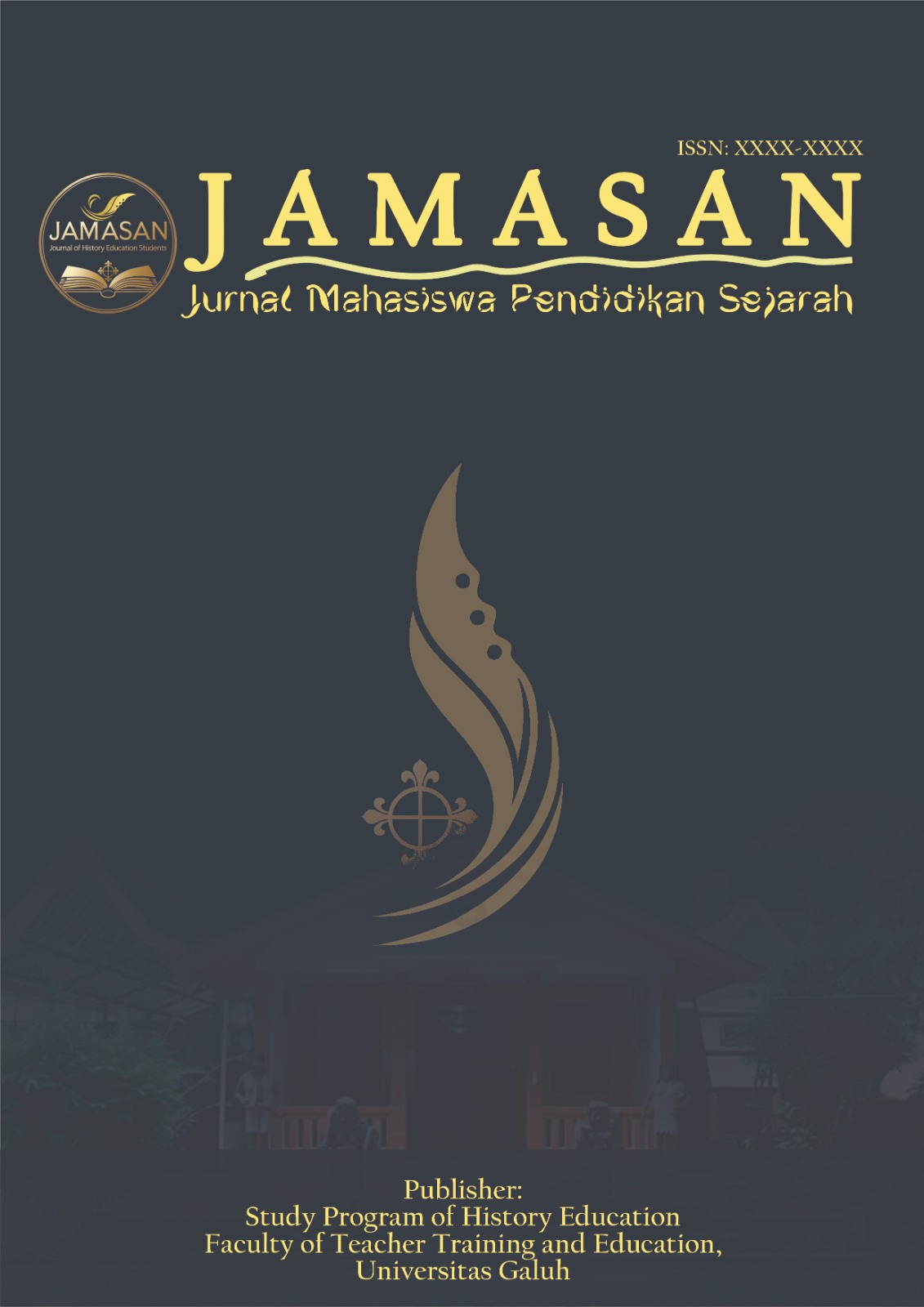Kampung Adat Pulo: Preserving the Harmony of Customs, Religion, and Traditional Sundanese Architecture
DOI:
https://doi.org/10.25157/jamasan.v1i1.5367Keywords:
History, customs, architecture, Pulo traditional village, HarmonyAbstract
Pulo traditional village is the embodiment of a unique combination of customs, history and architecture. The Kampung Adat Pulo has a mix of religions, starting with the community embracing Hinduism, Islam emerged with the arrival of Embah Dalem Arif Muhamad who stopped by after the defeat of the Dutch VOC and spread Islam. There are still strong customs that must be adhered to in the Kampung Adat Pulo, including not being allowed to add buildings, the traditional village can only be occupied by six houses of six heads of families from the lineage of Embah Dalem's daughters, which until now cannot be violated. And there are many other customs that cannot be violated, such as not being able to keep four-legged animals, not being allowed to hit large musical instruments such as gongs and many more. The architecture of Kampung Adat Pulo buildings is valued as a characteristic of traditional Sundanese buildings that are based on nature. which is still preserved.
References
Ardini, Mira, Muhamad Dikri Purnama, Muhammad Alisra Chivalry, Muhammad Iqbal Nugraha, Nashwa Fadila Dewi, and Puspita Puspa Anugrah. 2023. “Meninjau Perubahan Sosial Di Kampung Adat Pulo: Antara Modernisasi Dan Pelestarian Hukum Adat.” Causa: Jurnal Hukum Dan Kewarganegaraan 1 (11): 1–10. https://ejournal.warunayama.org/index.php/causa/article/view/1471.
Endraswara, Suwardi. (2004). Filsafat Arsitektur Jawa. Yogyakarta: Penerbit Kanisius.
Geertz, Clifford. (1976). The Religion of Java. University of Chicago Press.
Geertz, Clifford. (1983). Local Knowledge: Further Essays in Interpretive Anthropology. Basic Books.
Koentjaraningrat. (1985). Pengantar Ilmu Antropologi. Jakarta: Rineka Cipta.
Koentjaraningrat. (2009). Pengantar Antropologi. Jakarta: Rineka Cipta.
Nasution, A. H. (1986). Arsitektur Tradisional Nusantara. Bandung: ITB Press.
Nurhayanto, Puji, and Dadan Wildan. 2016. “Transformasi Nilai-Nilai Kearifan Lokal Masyarakat Adat Cireundeu.” Sosietas 6 (1). https://doi.org/10.17509/sosietas.v6i1.2872.
Nurholis, E., Sudarto, S., Budiman, A., & Ramdani, D. (2025). Strategi Adaptasi Sistem Pengetahuan Adat Komunitas Kampung Kuta dalam Menghadapi Tekanan Globalisasi: Studi Kritis Terhadap Ketahanan Budaya dan Konservasi Alam. Jurnal Artefak, 12(1), 237-254. http://dx.doi.org/10.25157/ja.v12i1.20928
Oliver, Paul. (1997). Encyclopedia of Vernacular Architecture of the World. Cambridge University Press.
Ratih, Dewi. 2015. “Komunitas Kampung Pulo Di Cangkuang Kabupaten Garut (Perkembangan Adat Istiadat Setelah Masuknya Islam).” Jurnal Artefak 3 (2): 119–30.
Ricklefs, M.C. (2001). A History of Modern Indonesia since c.1300. Palgrave.
Soekmono. (1973). The Javanese Candi: Function and Meaning. Archipelago Press.
Soekmono, R. (1973). Arsitektur Tradisional Indonesia. Jakarta: Penerbit Erlangga.
Soekmono, R. (1974). Pengantar Sejarah Kebudayaan Indonesia. Balai Pustaka.
Sudarto, S., Wijayanti, Y., Pramesti, C. S., & Agustina, D. D. (2024). Pengelolaan Pertanian Berkelanjutan Berbasis Eco-spirituality dalam Tradisi Komunitas Adat Dan Implikasinya Terhadap Ketahanan Cultural Socio-Ecological System (Studi Pada Tradisi Komunitas Adat Di Tajakembang–Cilacap). Jurnal Ketahanan Nasional, 30(3), 367-390. https://doi.org/10.22146/jkn.100561
Sudarto, S., Warto, W., Sariyatun, S., & Musadad, A. A. (2024). Cultural-Religious Ecology Masyarakat Pesisir Cilacap. Danadyaksa Historica, 4(2), 9-21. https://doi.org/10.32502/jdh.v4i2.8993
Suryana, A., Ratih, D., Sudarto, S., Sondarika, W., Wijayanti, Y., Kusmayadi, Y., ... & Wahyunita, R. (2024). Peranan Budaya Kampung Adat Kuta Di Era Globalisasi. http://repository.unigal.ac.id:8080/handle/123456789/6128
Downloads
Published
How to Cite
Issue
Section
License
Copyright (c) 2025 JAMASAN: Jurnal Mahasiswa Pendidikan Sejarah

This work is licensed under a Creative Commons Attribution 4.0 International License.
Articles published in JAMASAN: Journal of History Education Students are licensed under:
Creative Commons Attribution 4.0 International (CC BY 4.0)
This license allows readers and users to:
-
Copy, distribute, display, and adapt the work.
-
Use the work for any purpose, including commercial use.
Under the following conditions:
-
Attribution – Users must give appropriate credit to the original author(s) and the journal, provide a link to the license, and indicate if changes were made.
-
No additional restrictions – Users may not apply legal terms or technological measures that legally restrict others from doing anything the license permits.
Copyright remains with the author(s), while the journal retains the right of first publication.


